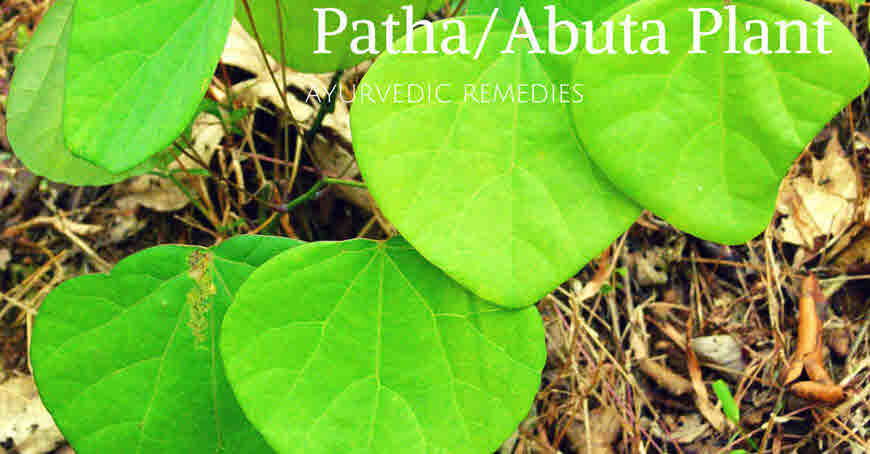Patha or Abuta is medicinal herb that is found throughout India up to an altitude of 2000 m. It is an extensively spreading, perennial climbing shrub that prefers warm and dry regions. For the medicinal purpose its roots and leaves are used. Patha is used by Acharya Charak for fever, vaginal discharge, piles, urinary ailments, digestive system complaints and uterine ailments. Acharya Sushruta, used this herb additionally for cleaning and washing of wounds (roots decoction).

General Information
Botanical name: Cissampelos pareira Synonyms: C. hirsuta Buch.-Ham.ex DC.
Family: Menispermaceae
Vernacular names
- Sanskrit: Ambashtaki, laghu patha
- Assamese: Tuprilata
- Bengali: Akanadi, Patha
- English: Velvet leaf
- Gujrati: Kalipath, Karondhium, Karondium, Venivel, Karedhium
- Hindi: Patha, Padh, Akanadi
- Kannada: Pahadavela, Agalushunthi
- Kashmiri: Pad
- Malayalam: Patha
- Marathi: Pashadvel, Paharrel, Pahadavel, Padali
- Oriya: Kanabindhi, Patha
- Punjabi: Patha
- Tamil: Vatta tiruppi
- Telugu: Adivibankatiga, chiru boddi, Boddi tiga
- Flowering and fruiting: April-October
- Habitat: Tropical and subtropical India (From Sind and Punjab to South India and Sri Lanka).
Plant description
Perennial climbing shrubs with small greenish-yellow flowers;leaves peltate or orbicular-reniform, ovate-subreniform, with truncate cordate base;inedible, dark, grape-sized berries;Flowers unisexual;male flowers with 4–5 sepals, ovate to obovate, hairy outside, greenish or yellowish, corolla cup-shaped, filaments of stamens completely fused;female flowers with 1 sepal, ovary superior, hairy, 1-celled, style thick with spreading, 3-lobed stigma;Fruit a short-hairy, orange to red drupe;Seed horseshoe-shaped;embryo elongate, narrow, embedded in endosperm, cotyledons flattened.
Constituents
Phytochemical are bioactive compounds that are found in plants. These active substance protects plant from various diseases and due to the presence of such compounds, the plants are useful in preventing and curing ailments. Different plants contains different phytochemicals.
This medicinal plant contains following phytochemicals in root:
Alkaloids (about 38 alkaloids), saponin and quarternary ammonium bases, flavonol and sterol.
Ayurvedic Properties and Action on body
- Rasa (Taste): Tikta/Bitter, Katu (pungent)
- Guna (Characteristics): Laghu/Light, Tikshna/Sharp
- Virya (Potency): Ushna/Hot
- Vipaka (Post Digestive Effect): Katu/Pungent
- Action: Decreases vata, kapha and increases pitta, Grahi, blood purifier, detoxifier
Medicinal uses in Ayurveda: Patha is used in the treatment of diarrhea, vomiting, fever, skin diseases, kandu and as galactodepurant (stanya sodhana).
Ayurvedic medicines containing patha
It is one of the ingredient in many Ayurvedic medicines. Few OTC medicines containing Patha are Pushyanug Churna (gynaecological ailments), Vrihat Gangadhar churna (diarrhea, amoebiasis), Pradrantak Churna (Pradar, female reproductive system diseases), Saraswat Ghrita.
Traditional Medicinal uses of Patha (Cissampelos Pareira)
Patha or abuta is an important medicinal herbs that is particularly used to treat gynaecological problems. Some tribes use roots of herb as contraceptive. The leaves exhibits antifertility activity in female albino rat.
Poultice prepared from Patha leaves is effective in skin diseases viz. abscesses, burns, boils, sores, scabies, itches, acne. Leaves are antiseptic and applied on inflammation and sores.
Abuta root is astringent, stimulates urine production, improves appetite, reduces fever and increases blood flow in pelvic region (reproductive organs, uterus). It tastes bitter and very pungent. In colic, 4 parts abuta, 5 parts pepper, 3 parts Hing, 6 parts ginger are mixed and pills are rolled adding honey. It is taken in a dose of three to five grains.